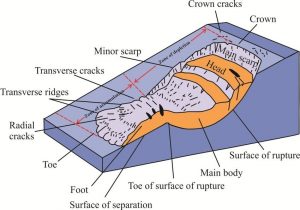Landslides
We have all heard about landslides. In news there are mostly mentioned in negative way, because they are identified with hazardous consequences and human victim. Lots of landslides are activated in a short period of time, due to extreme hydrological conditions in a relatively small area. What exactly are landslides? What are the most common causes of landslides? What are the types of landslides? Answers to these questions and other landslide facts can be read in our blog!
What are landslides?
Activating landslides causes lots of material damage and directly or indirectly endangers local community. Landslides always appear on or below the slope, and slopes are the most common morphological forms on Earth. According to Cruden (1991), “Sliding is the movement of a mass of rock, debris or earth down a slope. That includes all types of soil mass gravitational motion and rock mass, from rockfalls and topling rocks to rotational and translational slides and flow of different materials.”
Landslide is movement process, translational or rotational mass move over a stable subsoil. Movements are occurring along clear, and sometimes unclear slip surface. Mass moving down the slope can be slow and barely noticeable in time, but it also can be very quickly and devastating.
Types of landslides
Landslides are very diverse phenomena in shape and size, movement speed and other characteristics. According to geological structure in which landslides occur, we can distinguish instability in soil and rock mass.
In soil we distinguish the following types of instability:
- Rotational landslide
- Translational landslide
- Debris flow
- Debris avalanche
- Earthflow
- Creep
- Lateral spread
In rock mass we distinguish the following rock slope failure triggering mechanisms:
- Block slide
- Rockfall
- Topple

Photo 1 . Rockfall on the road Makarska-Vrgorac

Photo 2. Instability in soil and rock mass
Translational, rotational and crepping instabilities are the most common landslide types in Croatia while earthflows are not as common.
Landslide according to activity can be:
- active
- currently active
- reactivated
- inactive
- temporary stoped
- permanently stoped
- stabilized
- relict
Landslide parts
We can distinguish following parts of rotational landslide (the most common in Croatia): crown, toe, flanks, slipsurface, body, tension cracks.

Photo 3. Landslide parts
Where does landslides occur?
A surprising fact to many people is that landslides can occur virtually anywhere in the world. The traditional viewpoint that landslides are restricted to extremely steep slopes and inhospitable terrain does not accurately reflect the real nature of the problem.
Most countries in the world have been affected in some manner by landslides. Excessive precipitation, earthquake, volcanoes, forest fires and other mechanisms, and more recently, certain dangerous human activities are just some of the key causes that trigger landslides. Landsllides can occur both on land and under water; they can occur in bedrock or on soil; cultivated land; barren slopes and natural forests are all subject to landslides.

Photo 4. LaConchia landslide
What causes landslide?
There are two categories of landslide causes: natural and human causes. Somethimes landslide occures in combination of both.
When we talk about natural causes, we distinguish three main causes:
- water
- seismic activities
- volcanic activities
The primary cause of landslide activation is soil saturation with water and it can be formed during intense rainfall, snow melting, changes in groundwater regime along the coast (sea, lake and river). So landslide and flooding are closely related.

Photo 5. The Mameyes landslide 1985, Puerto Rico (Photo by Randall Jibson). The landslide destroyed 120 houses and killed at least 129 people. This landslide was triggered by a tropical storm that produced extremely heavy rainfall
Populations expanding (unfortunately not in Croatia) onto new land and creating neighborhoods, towns, and cities are the primary means by which human contribute to the occurance of landslides. Disturbing or changing drainage patterns, destabilizing slopes, and removing vegetation are common human induced factors that may initiate landslides. Other examples include oversteepening of slopes by undercutting the bottom and loading the top of a slope to exceed the bearing strength of the soil or other component material.
And for the end….
Effects and consequences on natural environment and population are very important.
Landslides are one of the most complex and popular theme in geotechnical engineering.
They are not completely explored, they are often unpredictable, and the consequences they leave are unimaginable. Landslide must be explored before landslide mitigation project started. Landslide mitigation project is designed by experts, after geotechnical exploration and investigation works.
More about some types of landslides, mitigation types and about our projects of landslide mitigation you can read in some of our next blogs.
Until then, if you have any questions or advice, be free to contact us!
